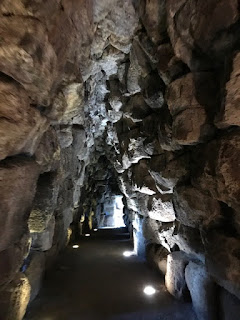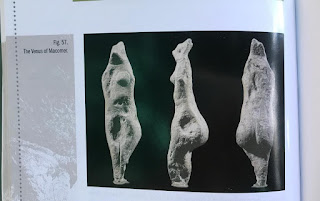Heading south through the island towards our penultimate destination (Tortolí) we reluctantly abandoned plans to look at Corsica across the sea, and chose a day of mountain driving instead. Over and again we were amazed and uplifted by the beauty of the landscape, especially in this late summer light. Although we had been completely satisfied with our visit to the nuraghe at Santa Barbara near Macomer, and had thought we would leave it at that, in the end we were tempted to visit one more…. said to be the most complete. (There are so many of them, and they are so central now to a particular kind of tourism, that each village will find a superlative quality to promote in its own local tower….). This one hits the guidebooks as being worth a visit, so we found a coffee in Humberto’s Bar in Thiesi (observing how rapidly the customers come and go, knocking back a tiny exquisite shot of espresso and then leaving), and then headed to their nuraghe. This is known now as Sant Antinu, and it sits on flattish land with distant mountains all around, in the so-called Valley of the Nuraghi.
We paid our €6 each for the visit, in a ranch-house style coffee-shop/ticket office with a largish car park, and ambled across the road towards the tower. It actually lost its top storey in the 19th century (agh!), but remains as a tall sturdy coffee-pot of a structure, much bigger and more massive, and supported by more outranges than Santa Barbara’s. The stones are blackened and dirty on one side, and washed cleaner where the prevailing winds have scoured them. Here again we have the motif of the steep deep doorway with its overflying window, and those astonishing staircases built inside the walls themselves. But here there are far more elaborate corridors leading round the ground-floor of the whole building, with passageways between them. It's hard not to imagine ceremonial use of all this, especially as a chamber at the back of the tower looks very cervical indeed.
The views from the top and from the ‘shoulders’ are lovely, and we could hear the bells on a flock of sheep nearby. It made me wonder how the people who built these things communicated with each other over inland distances - drums? smoke signals? pipes? On the flat lands of course they could run or walk or ride… but in the mountains and across the crevasses it would have been more difficult back in the stone age. And how did they get down to building these things? Manoeuvring the huge stones - even just collecting enough of them? Explaining the layout to new builders? This was before any writing was known… so was it scrawls in the sand? charcoal on rock? Who were the architects? The engineers? Were they men or women? I have so many questions. It’s plain to me that Earth (God) was female but somehow this tower has a masculine feel to it, elaborated and all about power and carefully-revealed mysteries. Perhaps we’ll never know.
After the disappointments of the museum in Sassari being closed, as also the local one in Thiesi, I was pleased to find a good selection of learned books in the ticket office, and bought one on Sardinia’s prehistory (I wish I had had this at the beginning of the trip), with excellent photos and information about artefacts (very early female figurine - 12,000 years old - from near Macomer, etc etc)….
And I bought a little female bronze figure - sadly with no kind of provenance and no info from the saleslady. This will add to my collection of 'goddesses'.
I must say, my understanding of some of the female figures has expanded - whereas I feel many of them are probably not goddesses at all but jujus made by women to preserve them through the perils of childbirth, nonetheless there are some figures which are so perfect, so radiant, that they must have a public or divine purpose....
 |
| Middle Neolithic or Copper Age, one holding a swaddled child |
They really are missing a huge opportunity here, the story-telling, the explanations…. You have to really search to find any information like this. Where you go, to the sites, is not really well explained if at all. And yet there's a heavy hand of public management about a lot of it, with railings, barriers, signs saying things like 'Archaeological area' which don't tell you much.
We arrived finally at the east coast - down into modern nondescript Tortoli, and found our slightly depressing quarters inside a holiday development… I dislike in myself the disgruntlement which attacks me from time to time, the dissatisfaction, the complaints. Of course, it’s all fine (and I am lucky), and we’ll get to know it better and settle in. But I am having a queasy kind of anti-tourism mood. Why do we do this? What damage do we do? I was cheered up by a little expedition to the local port which has such vibrant and interesting views - dockyards, cranes, railway line, business… and then the mountains to the west seen over the shining water…
We sat and had a drink taking it all in and will go back. And then I have been doing this blog, and making drawings and paintings which somehow have far more value to me than any photos (marvellous as the smartphone is).
This morning in bed I was reading about how Sardinia was settled in various unrelated stages during periods of glacial activity - the sea ‘migrated’ as they say, maybe as far down as 100m… leaving the island connected to Corsica at some period, and much closer to the Italian mainland. Tiny fragments of worked stone, or masticated bones, and similar evidence give us these clues. The first to arrive were maybe homo erectus, 500,000 years ago. The great ramp and ziggurat in the north at Monte d'Accoddi comes much much later - 4000 BCE. And these nuraghe towers about 1700BC.
We arrived finally at the east coast - down into modern nondescript Tortoli, and found our slightly depressing quarters inside a holiday development… I dislike in myself the disgruntlement which attacks me from time to time, the dissatisfaction, the complaints. Of course, it’s all fine (and I am lucky), and we’ll get to know it better and settle in. But I am having a queasy kind of anti-tourism mood. Why do we do this? What damage do we do? I was cheered up by a little expedition to the local port which has such vibrant and interesting views - dockyards, cranes, railway line, business… and then the mountains to the west seen over the shining water…
We sat and had a drink taking it all in and will go back. And then I have been doing this blog, and making drawings and paintings which somehow have far more value to me than any photos (marvellous as the smartphone is).
This morning in bed I was reading about how Sardinia was settled in various unrelated stages during periods of glacial activity - the sea ‘migrated’ as they say, maybe as far down as 100m… leaving the island connected to Corsica at some period, and much closer to the Italian mainland. Tiny fragments of worked stone, or masticated bones, and similar evidence give us these clues. The first to arrive were maybe homo erectus, 500,000 years ago. The great ramp and ziggurat in the north at Monte d'Accoddi comes much much later - 4000 BCE. And these nuraghe towers about 1700BC.









No comments:
Post a Comment